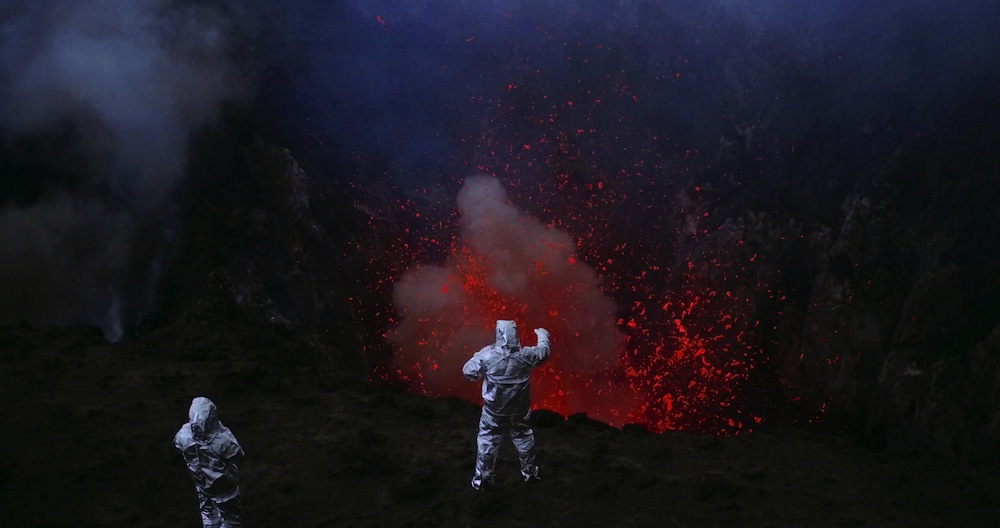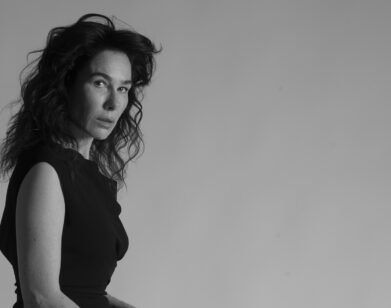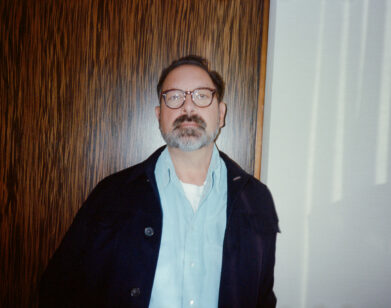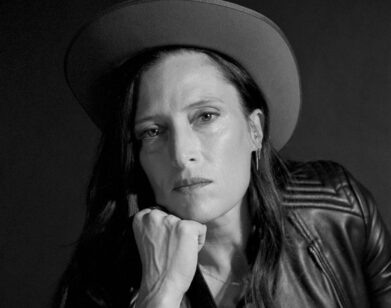Werner Herzog on Myths and Magma
PHOTOS COURTESY OF NETFLIX.
After spending time at Antarctic extremes, considering the life of a man who lived among grizzly bears, and studying humanity’s earliest pictorial cave drawings, it’s no surprise that filmmaker Werner Herzog recently found himself at the edge of volcano craters. In fact, this subject was a point of return for the prolific auteur; Herzog watched tens of thousands evacuate the island of Guadeloupe in advance of an eruption when filming La Soufrière (1978), and spent time at Mount Erebus, an active volcano in Antarctica, while filming Encounters at The End of The World (2007). During the latter he met volcanologist Clive Oppenheimer, whose 2011 publication Eruptions that Shook the World lured Herzog back to the magma. “This was getting more and more fascinating,” recalls Herzog. “I had no choice.”
Into the Inferno, the ensuing documentary (available now on Netflix), sees Herzog, usually accompanied by Oppenheimer, travel across the world: from a dove shaped church—which looks more like a chicken—near Mount Merapi in Indonesia; to North Korea’s Paektu Mountain (which has surprising connections to former dictator Kim Jong-il); to the East African Rift to unearth hominids. The science and spirituality surrounding these volatile ruptures in our Earth are both given due time, and the uncanny visual of volcanoes’ vast craters and shooting lava remind us of our scale.
Interview recently caught up with Herzog, who is based in Los Angeles, via phone to talk about eruptions, poetry, and how he’s “clinically sane” despite his daring reputation.
HALEY WEISS: What do you think it is about these extreme places, like volcanoes or being at the end of the world in Antarctica, that attracts these interesting characters?
WERNER HERZOG: Well, most of the volcanoes are pretty far away. You have to go to, God knows, Alaska. Or you have to go to the Southern Indies or you have to go to a specific island. However, there are a couple of volcanoes very close nearby, like Vesuvius in Italy right next to Naples. We have them also in our immediate neighborhood. I wish we didn’t have to travel that far. Probably the kind of magnitude and awesome raw power of them is very fascinating, and of course it’s very cinematic. When you look at my film you see footage that is unbelievably awesome and beautiful and dangerous looking. It’s something that is very, very cinematic.
WEISS: It looks like science fiction in the shots of volcanologists Katia and Maurice Krafft, where they’re in suits and there’s this wall of magma and operatic music. It almost difficult to believe that it’s something that’s here on Earth.
HERZOG: And of course it’s under us everywhere, under all continents, under the seabeds—we’re just not paying attention. Of course the entire planet Earth consists of magma under us, and only the very inner-core is different.
WEISS: I was struck by how disconcerting but also humbling it is to be reminded that what’s beneath us is shifting and impermanent. In the film you say how these volcanoes are “monumentally indifferent” to us and “could not care less about what we are doing up here.” I wonder if you revel in that indifference, in the power of them, or do you find that difficult to accept?
HERZOG: It’s pointing out that we are not that significant in terms of, let’s say, comparing us to nature or the universe. You see recent space probes that brought back images from Chury for example, a comet quite far out there. When the camera is looking back at our planet Earth, it’s the tiniest of specks somewhere out there in the universe. So we do have a new sense of proportion. Of course the volcanoes and the magma under us just remind us of that. We haven’t seen a real volcanic event at least in 74,000 years; [the eruption of Mount Toba] in Indonesia, in Sumatra, where the crater itself is 100 kilometers across—it was so monumental, what happened, that for a very long time the entire atmosphere of our planet was darkened. It’s not the lava and the heat per se; it’s the obscuring of the entire atmosphere, and it made it very difficult for the human race to survive. There are theories that only 600 of us were left alive on this planet, maybe 2,000, maybe 5,000—it’s very speculative.
WEISS: They do interrupt life in this monumental way. I think about the “Year Without Summer” in 1816, the year Mary Shelley wrote Frankenstein, when Mount Tambora erupted and temperatures changed, there was very little food… Volcanoes affect all of these things.
HERZOG: And the mass migrations. I think Irish people started to move to the United States—many things that were of consequence. And it was a tiny and mild event compared to what had happened 74,000 years ago. So it’s really, really awesome what can happen. But at the same time, there’s something magnificent about volcanoes; they created the atmosphere that we need for breathing.
WEISS: When you reflect on the film that you made about the volcano eruption in Guadeloupe, La Soufrière, you talk about how you were most attracted to that one man who seemed to have a “different attitude toward death,” who was just lying down.
HERZOG: Yes, he refused to be evacuated. 70,000 people were evacuated in a few hours, they fled. One poor farmer is just staying behind refusing to be evacuated. I found this very, very fascinating.
WEISS: I wonder how witnessing someone make that decision, and seeing the mass exodus of that area—how does witnessing something like that change your attitude toward death?
HERZOG: It doesn’t. I’ve done some thinking of my own. [laughs] But of course I’m very, very curious about how people live under the volcano, how they handle the permanence of danger. How all of the sudden do they create belief systems and new gods and demons? It’s very strange, for example, in North Korea where the volcano at the Chinese border is some sort of the mythical birthplace of the Korean people. That’s a myth going back 4,000 or 5,000 years. In the communist revolution in North Korea, when they threw out the Japanese occupiers, they claimed the power in the dynamic of this volcano for their revolution, saying that this is at the center of the dynamics of our revolution. Everything that you encounter—you don’t have, for example, any advertisements, you don’t have anything like that anywhere in the country—if you see anything it would be propaganda, and propaganda always inevitably comes back to the volcano. It’s always including the volcano. You see the new leader and standing behind him you see the volcano.
WEISS: In the first village you visited on Ambrym, you said that, “Time does not seem to have found a grip on the community.” That seemed true of North Korea as well with the lack of ads. They’re living in this surreal space.
HERZOG: It’s very enigmatic because of course, the population has no contact with the world outside or it’s very, very limited. They don’t have any telephone connections, no radio, no TV, no movies, no newspapers—nothing from the outside world. This is very strange and there’s the very strict, unifying government that forces you to be in step. You see it in the stadium where the spectators create, by flipping cards, an image of the dear leader, or of the volcano, and it’s made of a 100,000 human pictures. There’s some sort of a discipline and uniformity that is completely stunning.
WEISS: Do you think it’s just the power in the looming, uncontrollable nature of the volcano that makes these communities that are next to them build these mythologies around them?
HERZOG: I think so, yes. The power of a volcano when it erupts is so evident, so visible, so palpable. It’s not far-fetched that almost everywhere in the world where you have volcanoes you have mythologies or new gods being created, and North Korea is not an exception. Even there, where you think it would be completely sober, they have the myth of their revolution being connected to the volcano.
WEISS: I know you’ve said before that you’re looking for some sort of poetry or deeper truth when you’re constructing these narratives, but what’s your mindset when you enter a project like this? Is it just to be open to learning about what these people have to say?
HERZOG: Well, it’s curiosity, and always a sense of poetry. You see it in particular in the chapter “Iceland” where I’m reciting ancient Icelandic poetry. It has this very beautiful gravitas in conjunction with the volcanoes. I went to volcanoes where I knew that there was a lot of mythology around them; there was something like the creation of gods and monsters and demons. Of course, you do not do any research: you have to go there and do your film. It’s not that I would travel there before without a camera and spend half a year on one of those volcanoes and then come back with a camera. You have to have some sort of a clear mindset. You have to be completely open to what people would tell you. You do not shape them; you do not force the materials into your ideas. You have to have all windows and doors open.
WEISS: You’ve spoken about how you see yourself as having the right to trespass for the truth when you’re creating these documentaries. Can you elaborate a bit on what you mean by that?
HERZOG: When we speak about trespassing, we speak about artistic trespassing. You have to be prudent and have common sense and a sense of responsibility when you’re trespassing. I think you haven’t seen a film on volcanoes like that before. It’s not National Geographic. It is wildly imaginative and very poetic and has a sense of awe that you normally do not see in films. Of course I do things in my voice in my commentary, which I wrote. For example, at the end [when I speak about] magma under us everywhere, how it’s monumentally indifferent to scurrying roaches, recoiled reptiles, and vapid humans alike. You see, you would never hear anything like that in a National Geographic or a PBS movie. This is clearly a transgression when it comes to being politically correct with your commentary.
WEISS: You mentioned in the film that you’re the only clinically sane person in filmmaking and that you take all of these precautions. Why do you think Clive thought—when you were first going to visit the volcano in Antarctica 10 years ago—that you might propel him into the crater with a rope?
HERZOG: Well, there’s this kind of strange mythology about me in the media because I’ve done unusual things. I’ve pulled a huge steamboat over a mountain; I’ve done a feature film with all the actors acting under hypnosis—things that are very unusual. And I’ve done things that were physically daring. But they were very prudent, everything that I’ve done was prudent and never has anyone gotten hurt in my films—not a single actor, not a single extra, ever. But strangely enough, there’s this mythology sprouting out that I cannot stop. It would be senseless to try to talk up against it, but this climate surrounding me has reached Clive Oppenheimer. In practical terms he sees that I’m not interested in any sort of daredevil stunts, I’m just interested in the work. And he’s convinced that I’m clinically sane. [both laugh] Rightly so.
WEISS: Is there a reaction that someone has had to one of your films that has stuck with you over time, whether it’s positive or negative?
HERZOG: It seems odd, but people who see my films normally take them in in a deeper way than you would actually watch a film, let’s say The Terminator or whatever. It is something more fleeting than what you normally see. People might somehow take it into their own dreams, into their own life, in a way. I hear it more recently; people are telling me that when they leave the theater and see one of my films, they are not alone anymore. It’s probably more that kind of feeling. If I managed to do a film like that, everything is fine.
INTO THE INFERNO IS NOW AVAILABLE TO STREAM ON NETFLIX.







